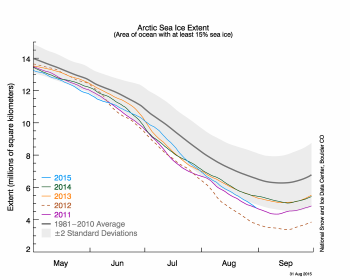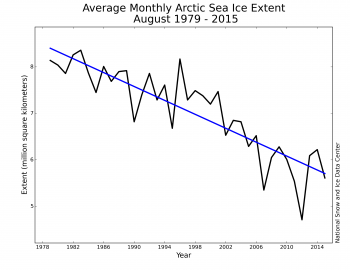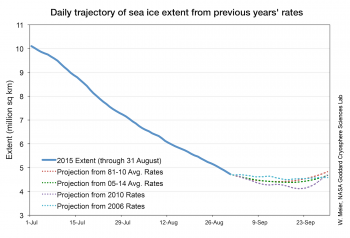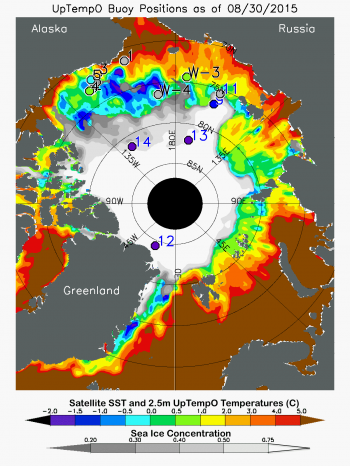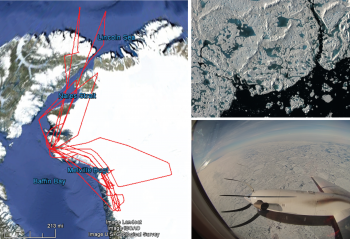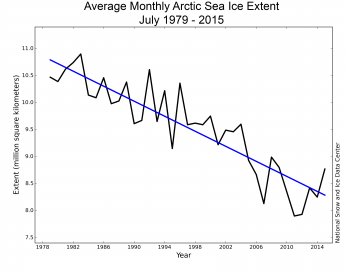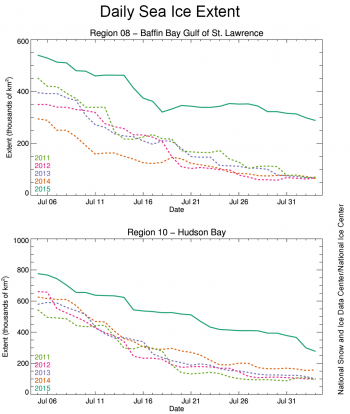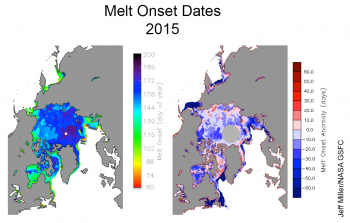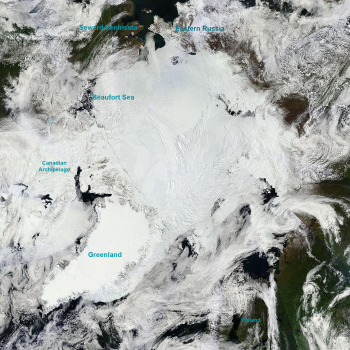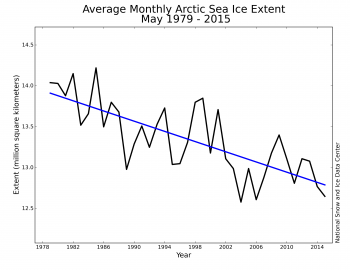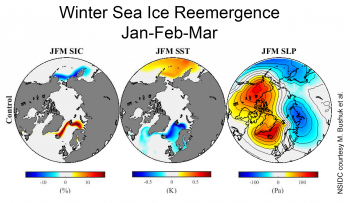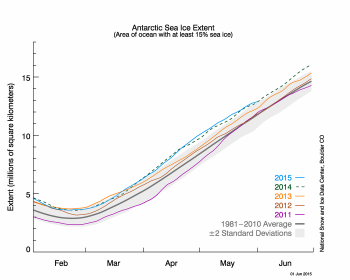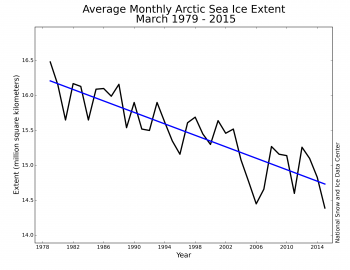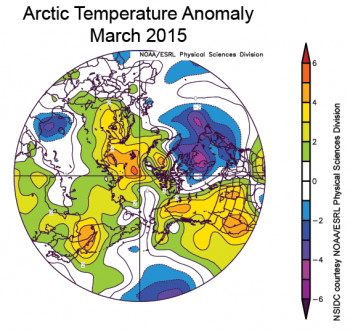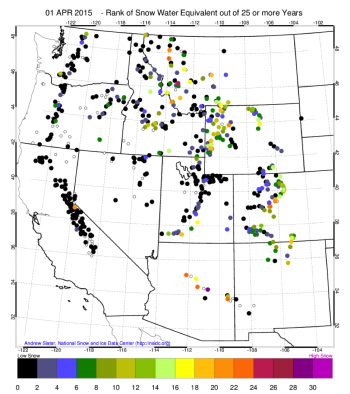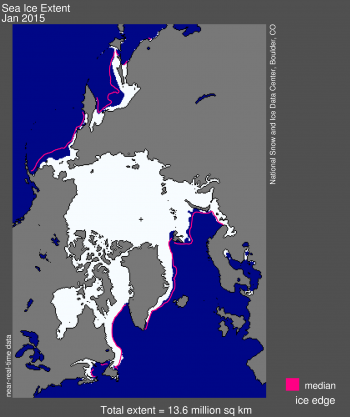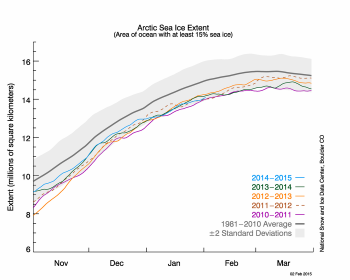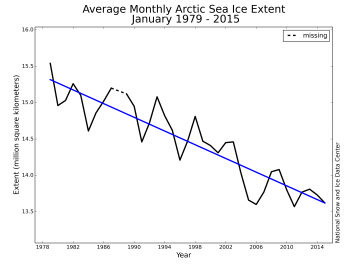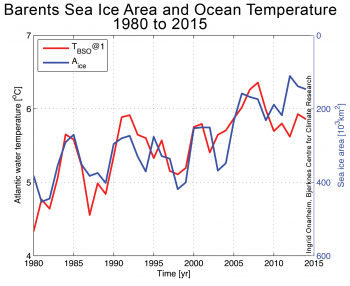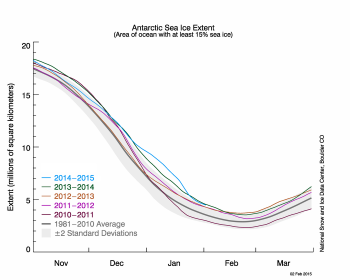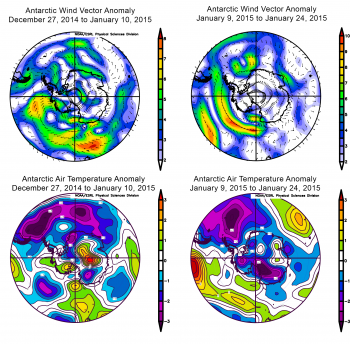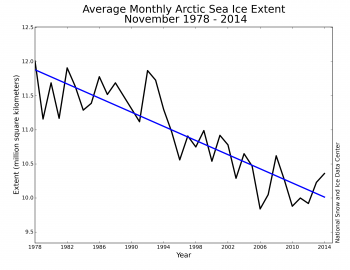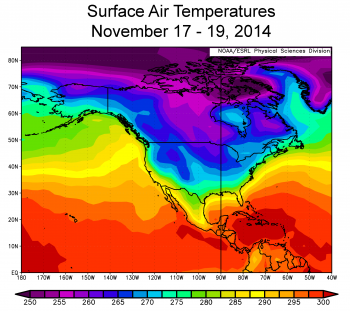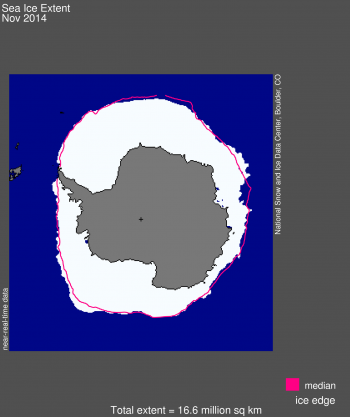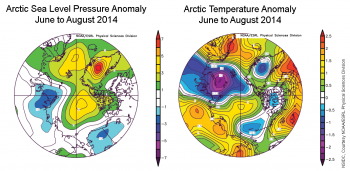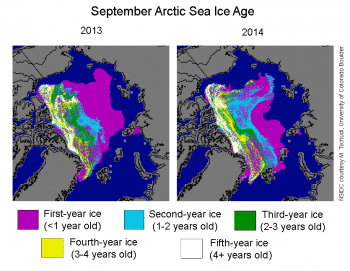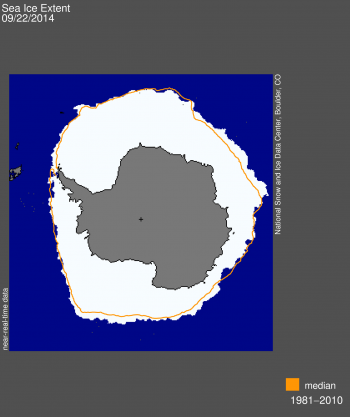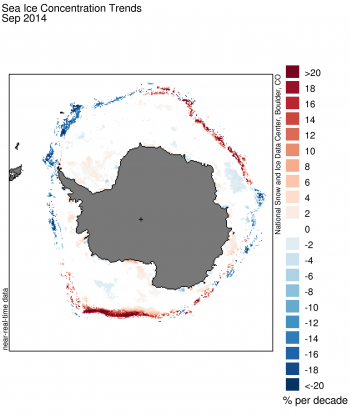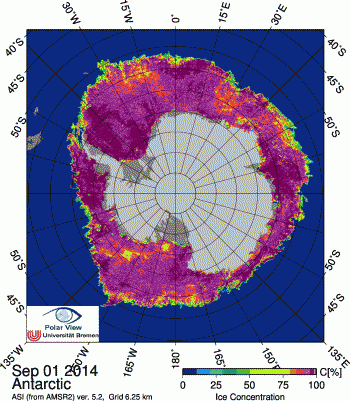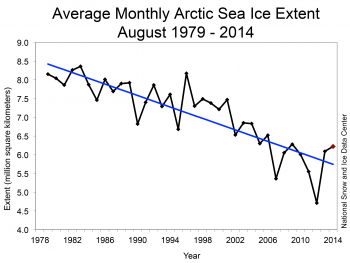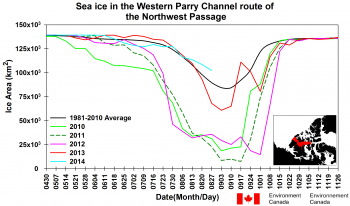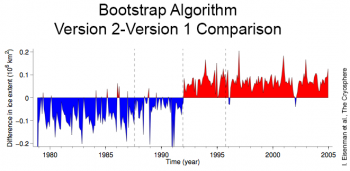The Arctic melt season has ended and sea ice extent is now increasing after reaching the fourth lowest minimum on record, on September 11. Sea ice extent in Antarctica has not yet reached its seasonal maximum.
Overview of conditions
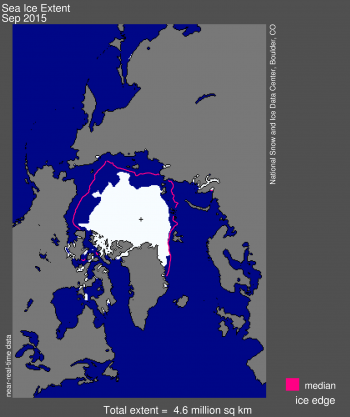
Figure 1. Arctic sea ice extent for September 2015 was 4.63 million square kilometers (1.79 million square miles). The magenta line shows the 1981 to 2010 median extent for that month. The black cross indicates the geographic North Pole. Sea Ice Index data. About the data
Credit: National Snow and Ice Data Center
High-resolution image
Following the seasonal daily minimum of 4.41 million square kilometers (1.70 million square miles) that was set on September 11, which was the fourth lowest in the satellite record, Arctic sea ice has started its cycle of growth. Arctic sea ice extent averaged for the month of September 2015 was 4.63 million square kilometers (1.79 million square miles), also the fourth lowest in the satellite record. This is 1.87 million square kilometers (722,000 square miles) below the 1981 to 2010 average extent, and 1.01 million square kilometers (390,000 square miles) above the record low monthly average for September that occurred in 2012. As of this writing, Antarctica’s winter maximum has not yet occurred, but is anticipated within several days.
Conditions in context
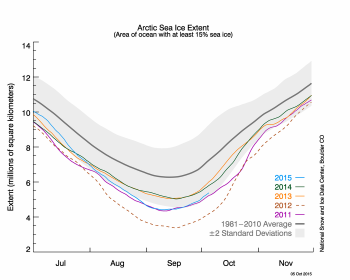
Figure 2. The graph above shows Arctic sea ice extent as of October 5, 2015, along with daily ice extent data for four previous years. 2015 is shown in blue, 2014 in green, 2013 in orange, 2012 in brown, and 2011 in purple. The 1981 to 2010 average is in dark gray. The gray area around the average line shows the two standard deviation range of the data. Note: This graph was updated to show the most recent years, in order to be consistent with our monthly posts. Sea Ice Index data.
Credit: National Snow and Ice Data Center
High-resolution image
For two weeks following the minimum extent on September 11, air temperatures at the 925 hPa level (about 3,000 feet above the surface) were 2 to 4 degrees Celsius (4 to 7 degrees Fahrenheit) lower than average in the Chukchi and Beaufort seas, helping foster ice growth in those regions. Elsewhere over the Arctic Ocean, there has been fairly little ice growth, in part due to near average to slightly above average air temperatures. Both the Northern Sea Route and Roald Amundsen’s route through the Northwest Passage appeared to remain free of ice at the end of the month. The deeper northern route through Parry Channel, which consists of M’Clure Strait, Barrow Strait, and Lancaster Sound, never completely cleared of ice.
September 2015 compared to previous years

Figure 3. Monthly September ice extent for 1979 to 2015 shows a decline of 13.4% per decade relative to the 1981 to 2010 average.
Credit: National Snow and Ice Data Center
High-resolution image
Through 2015, the linear rate of decline for September Arctic ice extent over the satellite record is 13.4% per decade. The nine lowest September ice extents over the satellite record have all occurred in the last nine years.
Conditions leading to this year’s minimum
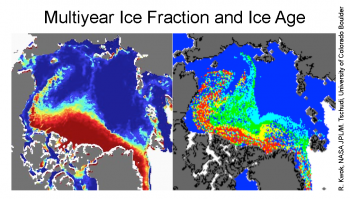
Figure 4a. The map at left shows multiyear ice fraction in mid-April derived from ASCAT, and the corresponding map at right shows ice age. ASCAT image courtesy of R. Kwok, NASA Jet Propulsion Laboratory. Ice age image derived from data provided by M. Tschudi, University of Colorado Boulder.
Credit: National Snow and Ice Data Center
High-resolution image
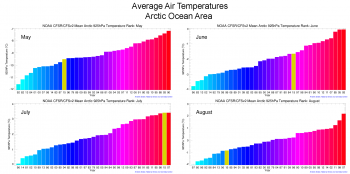
Figure 4b. The graphs show Arctic ocean air temperatures for May, June, July, and August at the 925 hPa level, ranked according to year from lowest (in blue colors) to highest (in red colors). Ranking of 2015 is given in yellow.
Credit: D. Slater, National Snow and Ice Data Center
High-resolution image
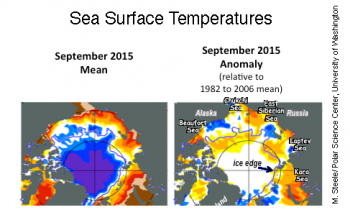
Figure 4c. The maps show Arctic sea surface temperature (SST) and anomaly in degrees Celsius, for September 2015. The image at left shows average temperature, with reds indicating higher temperatures and blues indicating lower temperatures. The map at right shows temperature anomaly, compared to the 1982 to 2006 average. Reds and oranges indicate higher than average temperatures, and blues lower than average. The grey line indicates the sea ice edge. SSTs are from from the NCDC OIv2 “Reynolds” data set, a blend of satellite (AVHRR) and in situ data designed to provide a “bulk” or “mixed layer” temperature. Ice edge is from NSIDC near real time passive microwave data.
Credit: M. Steele, Polar Science Center/University of Washington
High-resolution image
The summer melt season began earlier than average. The maximum winter extent, reached on February 25, 2015, was also the lowest recorded over the period of satellite observations. However, a relatively large amount of multiyear ice was transported into the southern Beaufort and Chukchi seas during the winter, as documented by images of multiyear ice fraction derived from the Advanced Scatterometer (ASCAT) instrument on the METOP-A satellite (Figure 4a). The corresponding ice age image shows that the multiyear ice largely consisted of floes that had survived several melt seasons, indicating that it was fairly thick. Thick ice is more difficult to melt out during summer than thinner ice; if not for this thicker ice, the September minimum extent would likely have been lower.
Melt onset began earlier than average in the Beaufort Sea, especially along the coast of Canada, leading to early development of open water in this area. Melt also began earlier than is usual in the Kara Sea, fostering early retreat of sea ice in the region. However, air temperatures at the 925 hPa level during May and June for the Arctic ocean region were not particularly high, ranking as the 26th and 13th warmest since 1979 (Figure 4b). As a result, although the winter maximum extent was the lowest in the satellite record, ice extent at the end of June was only the third lowest.
The pace of seasonal ice loss picked up rapidly in July, with Arctic ocean region temperatures at the 925 hPa level reaching the second highest during the satellite record (with 2007 ranked as the highest). Daily ice loss rates averaged 101,800 square kilometers (39,300 square miles) per day, the fourth largest rate of ice loss recorded for the month. Nevertheless, sea ice was slow to melt out of Baffin Bay and Hudson Bay, resulting in a July average extent for 2015 that was the eighth lowest on record. By the end of July however, the fast pace of ice loss during the month resulted in 2015 extent falling within 550,000 square kilometers (212,000 square miles) of the level recorded in 2012, and tracking below the levels recorded for 2013 and 2014. By the middle of August, the difference in extent between 2012 and 2015 had dropped to less than 500,000 square kilometers (193,000 square miles), hinting at the possibility that this year would rank among the lowest minimum extents recorded. However, temperatures for August were not particularly warm, and extent ended up fourth lowest.
Higher than average Arctic sea surface temperatures dominated the Arctic Ocean in September 2015 (Figure 4c), though not as high as seen in 2007 or 2012. Early melt onset as well as strong spring winds in the eastern Beaufort Sea led to early ice retreat in this area (Steele et al., 2015). These winds were particularly strong in April 2015, but then they abated, so that while the resulting summer sea surface temperatures were higher than surrounding waters, they were only around 2 to 3 degrees Celsius (4 to 5 degrees Fahrenheit) higher than average near the coast. The Kara Sea was also unusually warm this year, while sea surface temperatures were generally lower than average in the Nordic seas.
What happened to the old ice in the Beaufort and Chukchi Seas?
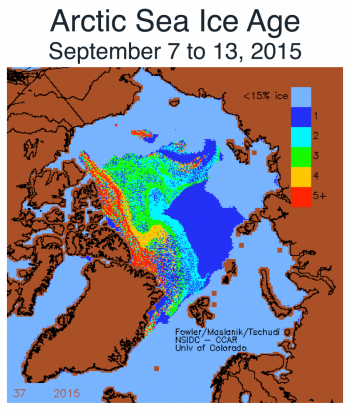
Figure 5a. The map shows Arctic sea ice age, in years, for the week of September 7 to 13, 2015.
Credit: M. Tschudi, University of Colorado Boulder
High-resolution image
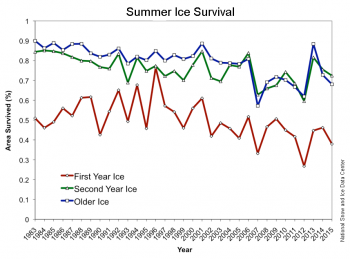
Figure 5b. The plot shows survival rates of first-year, second-year, and older ice, in percentage of area that survived.
Credit: National Snow and Ice Data Center
High-resolution image
Maps of ice age at the beginning of the melt season and at the time of the September minimum extent (Figure 5a) reveal that most of the old ice transported into the southern Beaufort and Chukchi seas melted out this summer. This resulted in a 31% depletion of the multiyear ice cover this summer for the Arctic as a whole, compared to only 12% in 2013 and 38% in 2012. There was also more first-year ice lost this summer than during the last two summers. Sixty-two percent of the winter first-year ice was lost. Overall, this was the third largest amount of first-year ice lost in a melt season, behind 2012 (73%) and 2007 (67%).
References
Steele, M., S. Dickinson, J. Zhang, and R. Lindsay. 2015. Seasonal ice loss in the Beaufort Sea: Toward synchrony and prediction, J. Geophys. Res., 120, doi:10.1002/2014JC010247.
Erratum
A reader alerted us that Figure 5a was mislabeled. Instead of Mid-March 2015, it should have been labeled September 2015. On October 8, 2015, we corrected the label and its caption.

